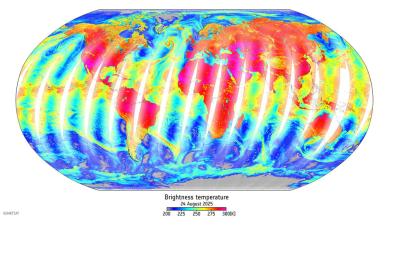Less than three weeks after its launch, the first MetOp Second Generation (MetOp-SG-A1) satellite has begun transmitting data from two of its six instruments, signaling a new stage in European weather and climate monitoring. Launched on August 13, 2025 aboard an Ariane 6 rocket from the European Spaceport in French Guiana, the satellite is currently undergoing commissioning. MetOp-SG-A1 is the first satellite in the EUMETSAT Polar System - Second Generation, which enhances Numerical Weather Prediction (NWP) models and provides essential atmospheric and oceanic observations.
Advancing Weather Forecasting through Collaboration
The MetOp-SG mission builds on the success of the first-generation MetOp satellites, ensuring a continued flow of data for global weather forecasting and climate monitoring. It introduces major improvements in performance and resolution, critical as extreme weather events become more frequent. Operating in polar orbit, the mission consists of three successive pairs of satellites, each carrying complementary instruments to capture a wide range of observations.
The program is a joint effort between ESA and EUMETSAT. ESA designed and developed the satellites, while EUMETSAT oversees launch services, ground segment development, satellite operations, and data distribution.

Early Instrument Results
The Microwave Sounder (MWS) and Radio Occultation (RO) instruments are already returning initial data. The MWS provides atmospheric temperature and humidity profiles, combining earlier instruments into a single antenna with new channels for temperature, humidity, and ice-cloud detection. Its resolution has improved from 48 km to 20 km at nadir, with 24 channels that will be combined to generate atmospheric products at different altitudes. Early imagery revealed convective clouds over the oceans, including the swirl of ex-hurricane Erin in the North Atlantic, and summer brightness temperatures over the land and ocean in Europe.
The RO sounder delivers detailed profiles of atmospheric temperature and humidity across the troposphere and ionosphere. Building on the GRAS instrument, RO now produces over 1,600 daily observations by using signals from GPS, Galileo, and BeiDou constellations. Measurements between August 20th and August 26th showed improved coverage of global oceans and refined ECMWF forecasts in data-sparse regions.
Phil Evans, EUMETSAT Director-General, declared, “Receiving these first data so quickly is a thrilling achievement for EUMETSAT, particularly considering the technological sophistication of MetOp-SG-A1 and its payload. In collaboration with ESA and our European industry partners, Eumetsat teams are working intensely to render all the satellite's instruments operational, and the fact that data is already flowing seamlessly from the MWS and the RO shows that we are firmly on the right track to having powerful, validated products ready for our user community in the planned timeframe.”

Looking Ahead
Both the MWS and RO will significantly improve the accuracy of NWP once validated, though the data are not yet operational and will undergo several months of testing and calibration before release to EUMETSAT Member States.
The companion satellite, MetOp-SG-B1, is in final preparation for launch next year. In total, the mission will deploy six satellites over the next two decades, ensuring continuity of critical observations. Together with the geostationary Meteosat Third Generation mission, MetOp-SG places Europe at the forefront of global weather forecasting.

